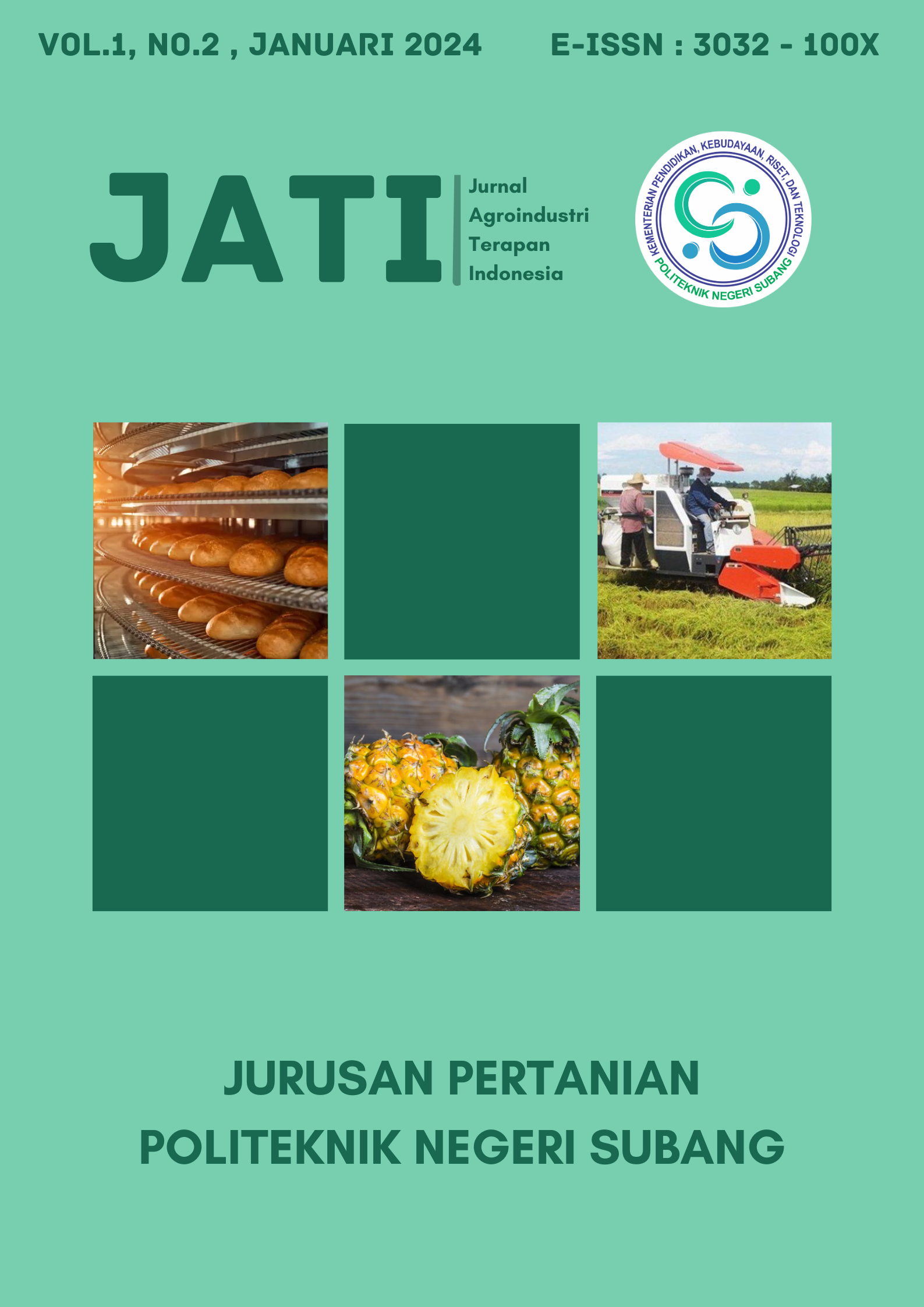Karakteristik Fisikokimia Cookies Tersubstitusi Tepung Suku (Artocarpus artilis) Physicochemical Characteristics of Cookies Substituted with Breadfruit Flour (Artocarpus artilis)
Main Article Content
Abstract
Breadfruit flour is gluten free so it is good to use as an alternative food in making cookies that can help children with autism and celiac diseases. The purpose of this research were to determine the effect of breadfruit flour on physicochemical characteristics of cookies as a substitute for wheat flour. This research used a completely randomized design with 4 treatments and 3 replications of breadfruit flour as a substitute for wheat flour, namely, FI=0%:100%, F2=20%:80%, F3=40%:60% and F4=60%: 40%. The parameters tested were water content, acid insoluble ash content, protein content and color test. The data were analyzed using ANOVA and further tests were carried out with DMRT analysis at a significant level of 5% and protein content using Microsoft Excel. The used of breadfruit flour substitute wheat flour had no significant effect on the water content, protein content, and acid of insoluble ash content. The results showed that all cookies with breadfruit flour substitution produced water content and acid insoluble ash content that still exceeded from SNI standards, while the protein content of all cookies met SNI standards. The resulting cookies each have a darker brownish color as the amount of breadfruit flour is added as a substitute.
Article Details

This work is licensed under a Creative Commons Attribution-NonCommercial-ShareAlike 4.0 International License.
References
Fatkurahman, R., Atmaka, W., & Basito. (2012). Karakteristik Sensoris Dan Sifat Fisikokimia Cookies Dengan Subtitusi Bekatul Beras Hitam (Oryza sativa L.) Dan Tepung Jagung (Zea mays L.). Jurnal Teknosains Pangan, 1(1), 49-57.
Kurniawati, K., & Ayustaningwarno, F. (2012). Pengaruh Substitusi Tepung Terigu Dengan Tepung Tempe Dan Tepung Ubi Jalar Kuning Terhadap Kadar Protein, Kadar Βetakaroten, Dan Mutu Organoleptik Roti Manis. Journal Of Nutrition College, 1(1), 344–351. Https://Doi.Org/10.14710/Jnc.V1i1.511
Saajidah, S. N., & Sukadana, I. W. (2020). Elastisitas Permintaan Gandum Dan Produk Turunan Gandum Di Indonesia. In Jurnal Ekonomi Kuantitatif Terapan (Vol. 13, Issue 1).
Sukandar, D., Muawanah, A., Amelia, E. R., & Basalamah, W. (2014). Karakteristik Cookies Berbahan Dasar Tepung Sukun (Artocarpus communis) Bagi Anak Penderita Autis. Jurnal Kimia Valensi, 4(1), 13-20. Https://Doi.Org/10.15408/Jkv.V4i1.1047
Swamilaksita, P. D., Yusuf, I. E., & Ronitawati, P. (2021). Berbahan Dasar Tepung Sukun (Artocarpus altilis ) Dan Tepung Kacang Tunggak Pendahuluan. 18.
Waryat, W., Rina Kamardiani, D., & Rahayu, L. (2016). Analisis Nilai Tambah Dan Usaha Pengolahan Tepung Sukun Sebagai Upaya Peningkatan Pendapatan Petani. Agraris: Journal Of Agribusiness And Rural Development Research, 2(2), 128-133. Https://Doi.Org/10.18196/Agr.2233
Widiantara, T., Arief, D. Z., & Yuniar, E. (2018). Kajian Perbandingan Tepung Kacang Koro Pedang (Canavalia ensiformis) Dengan Tepung Tapioka Dan Konsentrasi Kuning Tantan Widiantara. Pasundan Food Technology Journal, 5(2), 146-153.
Yanis, M., & Handayani, Y. (2014). Diversifikasi Pangan dari Tepung Sukun Untuk Mengurangi Konsumsi Tepung Terigu Di Kepulauan Seribu, Provinsi DKI Jakarta. 4, 13-19.
